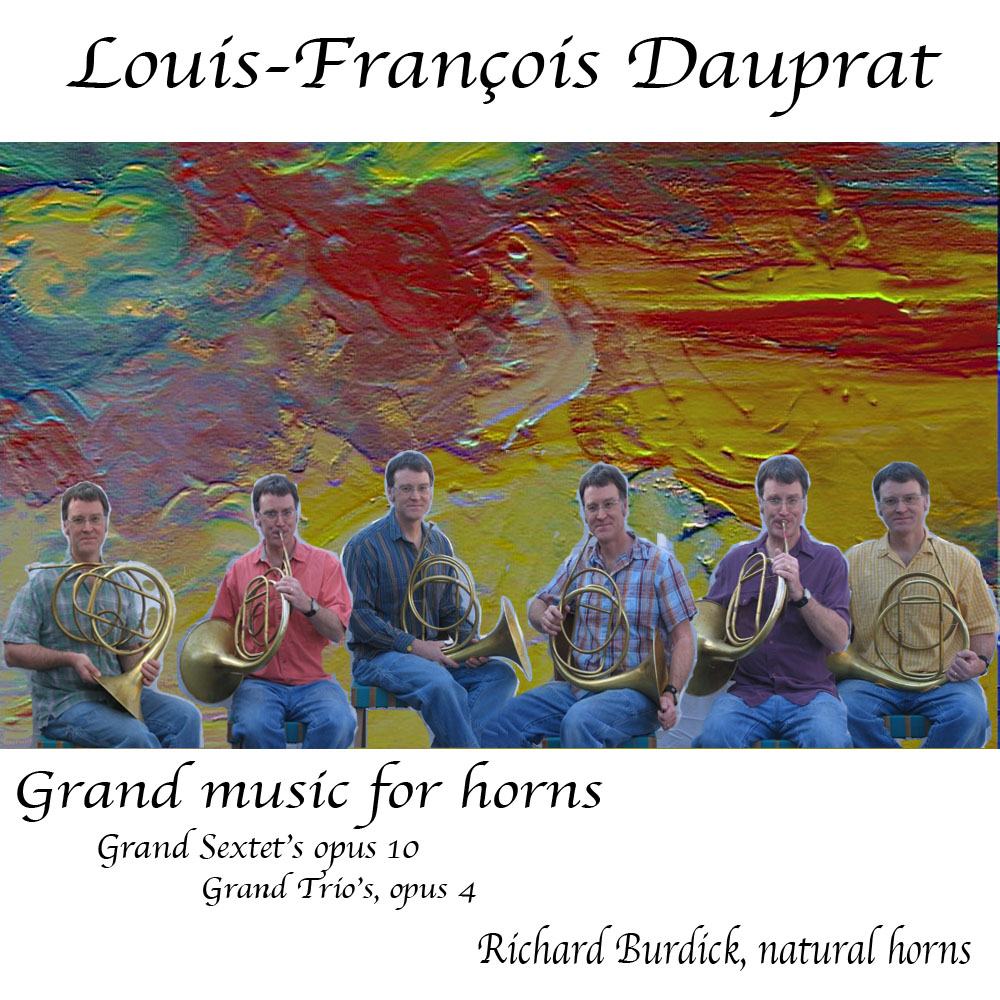| |
 CD19 CD19
 Louis-François Dauprat Louis-François Dauprat
Grand Music for horns
Grand Sextet's opus 10 for natural horns
in different keys
Grand Trio's opus 4 for natural horns in E
Richard Burdick, natural horns
This release
date marks the completion of the recording of all of Dauprat's
horn ensemble music by Richard Burdick. With the 2nd volume of
Horn Duets opus 13 on CD 18, the Grand Sextets, opus 10 and the
Grand Trios opus 4 on CD19 and a special release of the Grand
Trio opus 26 on a disk for those who buy both CD18 & 19!
This special release is only available from
www.i-ching-music.com
or
Naturalhorn.com
Buy just this CD:
Buy All Three CD's
Already
released are CD16; the Duets opus 14, and CD14; Quartets, opus
8; which is all of the published music for horn ensemble of
Dauprat.
Why is this important? Louis-François
Dauprat was the horn professor at the Paris conservatory in Beethoven's
time. He was singly responsible for stalling the development
of the Valve horn in France, by as much as 40 years! His compositions
are fine early romantic works highly influenced by his teacher
Anton Reicha. His writing for natural horn is unbelievably
chromatic with keys remote from what would be expected in what
normally would be a very limited instrument.
His works are outstanding! His
Grand sextets are his most popular works partially due to his
use of the High C horn, which results in high D for the modern
horn or concert G's above the treble clef staff!
Performance of his works could
only be done by a virtuoso! Great mastery of the natural horn
is required to play these works; hear one of today’s few
natural horn artist. in this amazing recording.
| Grand Sextets for horns in different keys, opus
10 by Dauprat |
|
| Grand Trios, opus 4 #1 |
|
| Grand Trios, opus 4 #2 |
|
| Grand Trios, opus 4 #3 |
|
| Total time 75:55 |
Dauprat’s intimate knowledge of hand
horn techniques makes this opus a compositional tour de force. Not
only does he use all twelve notes of the chromatic scale in nearly
every piece, he also pioneers the use of key signatures of up
to four sharps and four flats for an instrument which was generally
restricted to C major. His stated purpose in writing these duos
was
to write in all the major and minor scales practicable on a single
crook. His ideas of what was practicable went far beyond the
usual practice of his time, and his goal was at least as much
aesthetic as technical. He exploited the positioning of stopped
notes to produce distinct moods and tone qualities for each key,
much as J. S. Bach did in the Well-Tempered Clavier. For the natural
horn, C major and the sharp keys are cheerful and brilliant because
they contain many open notes. The sharp notes are often leading
tones, so the hand position is more open than would otherwise
be the case.
Dauprat pushes the natural horn to its limits
in remote keys. Volume 2 of these opus 13 duets written for Eb
horns are in three primary keys: #3 is in Bb Major, #5 in Ab
Major and #6 is in G Major. Bb major puts the fundamental on
the 3rd, 6th or 12th harmonic of the horn, which is not too unusual,
but Ab Major puts the fundamental either on a 3rd or 6th harmonic
lowered a whole step by the hand and mouth use, or the 11th harmonic
dropped down 3/4 of a
step - difficult tone control is need for this key. And the 6th
duet is in G Major with departures to C minor, B Major, Ab Major,
and more. Fundamentals on the 5th or 10th harmonic aren’t
too bad, but Ab Major is done almost entirely with the bell covered!
Unheard of by any other composer! The stopped notes sound veiled
and mysterious, rather than deficient. This sound was so highly
regarded that the Conservatoire National did not discontinue
its natural horn curriculum until 1903!
Richard plays a horn made by Marcel-Auguste
Raoux in the 1840s, modified by Lowell Greer.
|
|